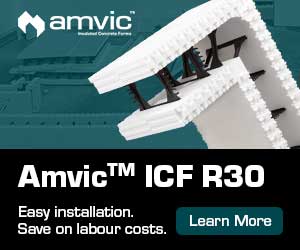By Dave Gowers
ICF systems are used extensively throughout the construction industry for a variety of building applications, such as private dwellings, commercial, and industrial buildings. However, applications other than buildings can be ICF-appropriate too. This would include structures where energy efficiency may not be of prime concern, but speed of construction, and associated labor savings, would be the main objectives. The following is a review of why ICF would be a good choice for a contractor considering one of these applications.
Applications Other Than Enclosed Buildings
One obvious application is free-standing retaining walls. These could be low-height site walls or landscaping walls. Or they could be substantial-height bluff retention retaining walls. In either case, waterproofing products are available for the ICF foam finish on the earth face. And for the exposed face, a number of finishes are possible, including stucco, stone, and brick, to name a few.
Other examples of non-building applications might be storage tanks, culvert header walls and abutments, above-ground boundary walls, bridge abutments and wingwalls, tunnels, etc. These have traditionally been built with either conventional forming systems, or custom modular systems, both with costs as described in the next section.
Conventional Forms & Forming
I’ve been involved with conventional, and custom, concrete forms for more than 50 years, and have designed the application of them for commercial and heavy civil applications for about the same amount of time. When I first came to the US over 40 years ago, I encountered snaptie systems for the first time. There’s no doubt that snapties have their place in construction, but in many cases, they can be replaced with ICF form systems.
The problem with conventional forms is the labor factor, which is significant, and includes the following activities: storage at an equipment yard, shipping from the equipment yard, unloading at the jobsite, placing/installing at the application location, stripping from the hardened concrete, cleaning at the jobsite, loading for site removal, shipping back to the equipment yard, unloading at the equipment yard, and storing once again at the equipment yard. These activities apply whether the forms are owned or rented. If owned, the material cost may have been amortized over several previous projects, but if rented, there is a material cost directly applicable to the project. Several studies have been done at various times, which show that 70% of the total forming cost of a project is labor.
ICF Forms As An Alternative to Conventional Forms
By contrast to the above, using ICF forms to produce the same finished product (e.g. a free-standing retaining wall), the activities are reduced to the following: loading for shipment, unloading at the jobsite, placed/installed at point of use, and the cost of the ICF form. And unlike conventional forms, all the ICF handling can be done without the need for mechanical equipment.
One significant advantage of ICF over conventional forming methods is that it’s very user-friendly. With the current industry-wide shortage of skilled labor, a contractor with only a basic forming background can quickly get up to speed with ICF installation. Minimal tools are required, compared with those needed for conventional forms. Basic ICF installation is very straightforward and requires a smaller crew. Bringing in additional labor just for concrete placement days dramatically reduces the build cost. Also, the ICF installation learning curve is much faster than for other trades, which means revenue-earning production work can be undertaken in the shortest possible time.
Speed of Construction
Typically, ICF construction will be faster when compared with the same application using conventional forms. The ICF form is self-contained at the time of placement, with the necessary “form ties” already being in place as an integral part of the ICF system. Therefore, no additional labor is required to set form ties. Placing both horizontal and vertical rebar within the ICF, typically without physical ties, is yet another labor-saving feature.
Design Considerations
Depending on the particular construction project, some design considerations might be necessary. This might include rebar sizing and placement. Typically, the structural designer will strive to provide a rebar layout that coordinates with the ICF block height and the ICF web spacing. If undertaken at the outset, knowing that ICF forming will be employed, there will be no additional cost. ICF core sizes typically come in 2-inch increments from 4 inches through 12 inches. Some ICF systems can accommodate core sizes greater than 12 inches. And in many cases, systems can be site-assembled around the rebar, if it was necessary to install the rebar ahead of ICF installation.
The net result of all the above is that using ICF forms to replace conventional forms where possible will lead to labor savings and consequent project cost savings. With escalating construction costs across all sectors, cost management and cost control on projects of all sizes is increasingly more important, to ensure that projects are delivered within budget.

Dave Gowers
In the 51 years since graduating from London University in the United Kingdom, Dave Gowers has acquired extensive experience in concrete construction through diverse commercial, residential, and industrial projects, up to $1-billion in value, in several countries. Dave resides in Southern Oregon with his wife and business partner, Jennifer. Dave holds a PE license in 14 states/territories and is the principal of Dave Gowers Engineering LLC, and co-principal of Cascade ICF LLC. He can be reached at 541-660-9661 or dave@dgengineering.com.








